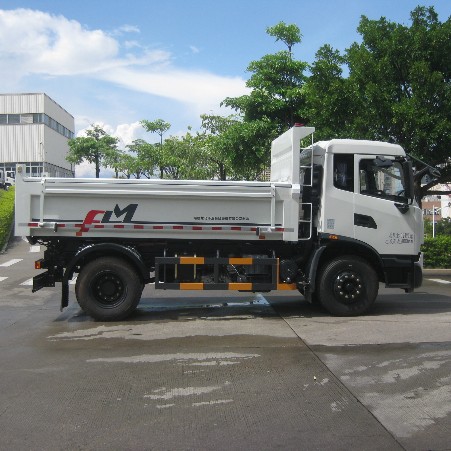Maintaining the cleanliness and waste-free status of our urban environments is a formidable challenge, at the core of which lies the indispensable role of garbage collection vehicles. These robust machines, often underappreciated, serve as the linchpin of contemporary waste management infrastructures. Their capacity to efficiently transport and compact substantial volumes of refuse ensures the seamless operation and hygiene of our cities.
This article delves into the advanced features, technological innovations, and strategic methodologies that empower these vehicles to achieve optimal performance. From engineering marvels to state-of-the-art technology, we will explore how these vehicles are revolutionizing waste collection, paving the way for a more sustainable and hygienic future.

Engineering and Design Features of Dumpster Trucks
Advanced Compaction Systems
A hallmark feature of contemporary refuse collection vehicles (RCVs) is their state-of-the-art compaction systems. These systems are engineered to compress waste material as loaded, significantly increasing the vehicle’s carrying capacity. By reducing the volume of waste, these compaction mechanisms minimize the frequency of trips required for collection, leading to substantial savings in terms of time, fuel, and labor costs. The efficiency of these systems is further enhanced by robust hydraulic actuators and sophisticated control algorithms, ensuring optimal performance and minimal downtime.
Ergonomic Design Considerations
- Low-Loading Heights: This design element reduces the physical strain on operators during the loading process, minimizing the risk of musculoskeletal injuries.
- Automated Lifting Mechanisms: These systems, often referred to as automated side loaders (ASLs) or rear loaders, use hydraulic arms to lift and empty dumpsters, eliminating the need for manual lifting and thus reducing the physical demands on the operator.
- Intuitive Control Interfaces: User-friendly control panels and interfaces simplify the operation of the vehicle, allowing operators to focus on the task at hand without unnecessary cognitive load. This thoughtful design enhances the workflow and improves overall productivity and job satisfaction.
Hydraulic Power Systems
The core functionality of RCVs is driven by highly reliable and efficient hydraulic power systems. These systems are responsible for a range of critical operations, including:
- Lifting Mechanisms: Hydraulically powered arms and lifts ensure the precise and controlled movement of dumpsters and other waste containers, handling heavy loads with ease.
- Compaction Operations: Hydraulic rams and cylinders provide the necessary force to compact waste, maintaining consistent pressure and ensuring uniform compaction throughout the collection process.
- Unloading Procedures: The unloading process, which involves tilting the truck bed and ejecting the compacted waste, is facilitated by powerful hydraulic actuators, ensuring a smooth and controlled operation.
The integration of high-performance hydraulic components, such as piston pumps, valves, and actuators, ensures that these systems operate with precision and reliability, even under the most demanding conditions. This robust engineering is crucial for the seamless and efficient operation of RCVs, making them indispensable in modern waste management operations.
Technological Advancements in Waste Management

Automation
Automation has transformed the waste management sector, with dumpster trucks at the forefront of this revolution. Modern trucks are equipped with automated arms capable of lifting, emptying, and returning bins with minimal human intervention. This automation not only reduces operational errors but also enhances collection efficiency and operator safety.
Telematics Systems
Telematics systems enable real-time monitoring of dumpster trucks, providing valuable data on fuel consumption, route efficiency, and maintenance requirements. By leveraging this information, fleet managers can make data-driven decisions to optimize performance, reduce downtime, and ensure that resources are used more effectively.
Eco-Friendly Innovations
As sustainability becomes a key priority, the waste management industry is increasingly adopting eco-friendly technologies. Hybrid and electric dumpster trucks significantly reduce fuel consumption and emissions, while advanced filtration systems minimize air pollution. These green innovations not only contribute to environmental protection but also lower long-term operating costs.
Waste Collection Strategies

Route Optimization
Efficient route planning is essential for minimizing travel time and fuel consumption. Advanced GPS and routing software are employed to design the most efficient collection paths, ensuring that trucks reach all designated points with minimal backtracking. This strategic approach conserves resources and reduces the carbon footprint associated with waste collection.
Scheduled Pickups
Scheduled pickups align waste collection with predictable patterns, such as peak trash days in residential areas or high-traffic business zones. By adhering to a well-structured schedule, dumpster trucks can operate consistently and avoid unnecessary trips, thereby enhancing overall operational efficiency.
Dynamic Adjustments
Waste production levels can fluctuate, necessitating dynamic adjustments in collection strategies. Real-time communication between trucks and central dispatch systems allows for adaptive responses to changes, such as holiday surges or unexpected events. This ensures that resources are allocated where they are most needed, maintaining optimal service levels.
Conclusion
Dumpster trucks are no longer just large vehicles for hauling garbage; they are sophisticated machines designed for maximum efficiency and sustainability. Through innovative engineering, advanced technology, and strategic operations, these trucks play a critical role in maintaining clean and green communities.
As the waste management industry continues to evolve, dumpster trucks are leading the way in smarter and more eco-friendly solutions. They exemplify how even the most challenging tasks can be executed with precision, care, and innovation.
FAQs
How do dumpster trucks compact waste?
Dumpster trucks use hydraulic-powered compactors that compress waste as it’s loaded. This reduces the volume of trash, allowing the truck to carry more in a single trip. The compactors are robust enough to handle various materials, from household garbage to bulky debris.
What are the environmental benefits of modern dumpster trucks?
Modern dumpster trucks often feature hybrid or electric engines, reducing greenhouse gas emissions. Additionally, their efficient compaction systems and optimized routes help conserve fuel. These advancements contribute to a lower environmental impact and a cleaner planet.
How do cities manage dumpster truck routes?
Cities use advanced route optimization software to plan the most efficient paths for dumpster trucks. These systems consider factors like traffic, distance, and waste production patterns to minimize travel time and fuel usage. Real-time data also allows for dynamic adjustments based on changing conditions.






